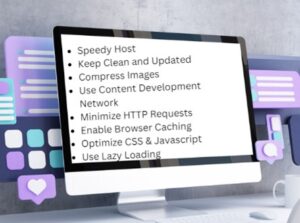The need for speed is real. Especially on the Internet, where everything must “go fast.” As a business website owner, you must ensure your digital presence is ready to stand and deliver.
Today, we’re diving into steps you can take to turbocharge website speed, provide a smoother ride for your visitors, and reap better results. Whether you’re a small business owner, the director of a nonprofit organization, or a fresh startup, these tips are for you.
Choose a Speedy Host
 Your web host is the foundation of your site. So, your site is only as strong as the hosting infrastructure. Choosing a reliable host with robust bandwidth helps ensure a faster website. Opt for a WordPress host known for offering speed and reliability. Doing so is akin to choosing a high-performance engine or installing brand – new tires for your car – it makes all the difference.
Your web host is the foundation of your site. So, your site is only as strong as the hosting infrastructure. Choosing a reliable host with robust bandwidth helps ensure a faster website. Opt for a WordPress host known for offering speed and reliability. Doing so is akin to choosing a high-performance engine or installing brand – new tires for your car – it makes all the difference.
Keep It Clean and Updated
Let’s return to the example of a WordPress website being like a high-performance racing vehicle. Every plugin or theme plays a role in site performance. Just as in racing, every component has to run optimally for safety and peak function. Your website requires all its elements to be up to date for optimal performance.
Keep in mind that independent creators develop many plugins and themes. While this openness creates a rich ecosystem of plugins with features and functionalities, it also means a wide range of update schedules and support levels exist. WordPress plugin developers are fantastic at bringing new ideas and tools to the WordPress community, but updates can vary in frequency and urgency.
Why does this matter? Outdated plugins or themes can create weaknesses, like a car engine that goes without care or maintenance. Hackers and malicious actors often target known vulnerabilities with ill
intent, like gaining unauthorized access or defacing your website. They’re always looking for any security holes they can exploit, and an outdated plugin can provide just the opening they need.
So, keeping plugins and themes updated is more than getting the latest features; it’s a critical step in safeguarding your site. Every update can handle multiple concerns, such as patching security vulnerabilities, fixing bugs, and improving speed, ensuring your website remains
secure and efficient.
Neglecting these updates can have results like those you get when you skip regular car maintenance – it will probably run fine for a while. Still, every day you ignore the issues, you’re increasing the risk of a breakdown significantly.
Compress and Optimize Images
While beautiful imagery enhances the web experience, unoptimized videos and images can be heavy, slowing down your site. Before uploading the original video or image material, compressing them first is a way to avoid losing quality. Also, pick the most suit-able format: JPEG for photos and PNG for graphics. Like packing a suitcase, you can fit more in if everything inside is compact and tucked away smartly.
Use a CDN – Content Delivery Network
CDNs keep a copy of your site on servers worldwide. Whenever and wherever visitors are domiciled, the content gets delivered from the closest available server. Using a CDN is comparable to having multiple express lanes on the highway. It reduces the number of hops that cause website latency, reduces website traffic congestion, and speeds up the journey.
Minimize HTTP Requests
Every website element generates a separate HTTP request, including pictures, scripts, and videos.
The more you can reduce these requests, the faster your response time. Consider simplifying your design and combining files where possible. It’s like clearing the road of unnecessary traffic, allowing for a faster commute.
Enable Browser Caching
Enabling browser caching is like giving your website a memory boost. When visitors return to your site, their browsers remember some of their previous journeys, thanks to caching.
Images, stylesheets, and JavaScript files are stored locally in the visitor’s browser; on subsequent visits,
it loads much faster.
Think of a seasoned traveler with the best routes through a city, bypassing the congestion and crowds. Caching improves the user experience with swift navigation and also reduces the load on your server, which can be especially beneficial during traffic spikes. With browser caching, you’re laying out a
welcome mat for repeat visitors, ensuring their return trips are smooth and speedy.
Optimize CSS and JavaScript
Streamlining or minimizing CSS and JavaScript can significantly speed up WordPress websites. Installing tools like CSS Minifier and JavaScript Minifier can help your site run more efficiently – with less drag and more speed.
Use Lazy Loading
Lazy loading maximizes efficiency by only loading images and videos when visitors scroll and the
request comes into view. It’s like turning on the lights in a room only when you’re about to enter – it saves energy and speeds things up.
Frequently Asked Questions
Q: How often should I update my WordPress themes and plugins?
A: Aim for regular checks at least once a month. It keeps your site secure and speedy.
Q: Can too many plugins slow down my WordPress site?
A: Yes, every plugin adds a bit of load. Keep your plugin count lean and mean by only using essential ones.
Q: Can I tell if my images are web-optimized?
A: Yes, you can use tools like TinyPNG or ImageOptim. They’ll ensure your images are web-ready without the risk of losing photo quality.
Q: I have a small website. Do I need a CDN?
A: It depends on your audience. A CDN can improve loading times worldwide if you have a global audience. For a local audience, it might be less critical.
Speed Up Your Site and Reap Greater Rewards
By following these tips, you’re not just improving your site’s speed; you’re enhancing the overall experience for your visitors. A fast website keeps users happy, improves search engine rankings, and boosts your online presence.
Contact Info:
Kevin McNally
Interactive Palette
Mailing: P.O. Box 1007
Fall River, MA 02722
Physical: 25 Braintree Hill Park
Braintree, MA 02184
interactivepalette.com
(781) 930-3199
sales@interactivepalette.com


